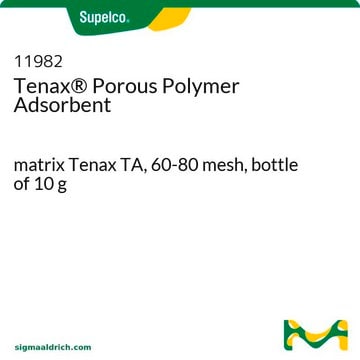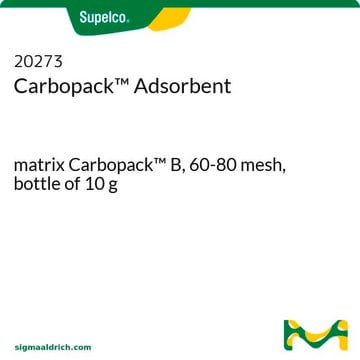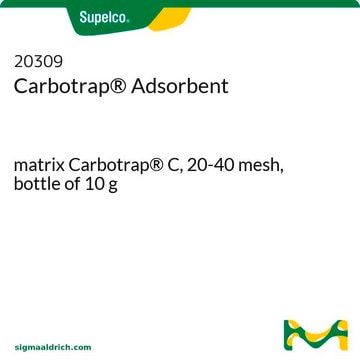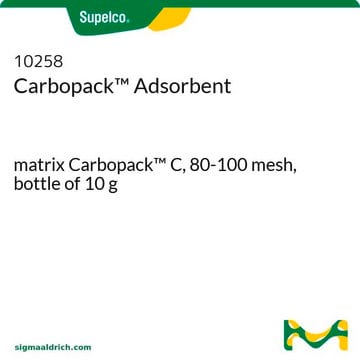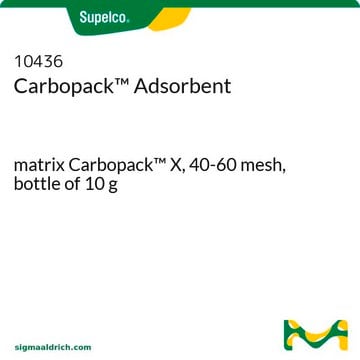おすすめの製品
製品種目
Carbotrap®
形状
granular
包装
bottle of 10 g
テクニック
LPLC: suitable
表面積
~100 m2/g
マトリックス
Carbotrap® B
マトリックス活性基
carbon
粒径
20-40 mesh
ポアサイズ
0 Å pore diameter
~0 cm3/g macroporosity
~0 cm3/g mesoporosity
~0 cm3/g microporosity
密度
~0.38 g/mL (free fall density)
分離法
reversed phase
関連するカテゴリー
詳細
黒鉛化カーボンブラック(GCB)には無孔質と多孔質の両方があります。黒鉛化プロセスにより優れた吸着性と脱離性(必要な場合)を持つ高純度表面が得られます。表面相互作用はロンドン分散力にのみ依存します。この粒子の性質や特徴は以下のとおりです:
一般にGCB吸着剤は、炭素分子ふるい(CMS)吸着剤と比べて低い相対吸着強度、球状黒鉛化ポリマー炭素(SGPC)吸着剤とほぼ同じ相対吸着強度を発揮します。弊社のCarbotrap製品はGCB吸着剤の一種です。
弊社の特殊炭素吸着剤に関する詳細情報については、こちらをご覧ください:sigma-aldrich.com/carbon
- 顆粒状
- 砕けやすい
- C3~C20以上のn-アルカンに対する分析物サイズの分子に使用
- 疎水性(高湿度環境での使用が可能)
一般にGCB吸着剤は、炭素分子ふるい(CMS)吸着剤と比べて低い相対吸着強度、球状黒鉛化ポリマー炭素(SGPC)吸着剤とほぼ同じ相対吸着強度を発揮します。弊社のCarbotrap製品はGCB吸着剤の一種です。
- 粒子は20/40メッシュです
- このように大きな粒子により、過度に圧力を低下させず高い流速を実現できます。
弊社の特殊炭素吸着剤に関する詳細情報については、こちらをご覧ください:sigma-aldrich.com/carbon
法的情報
Carbotrap is a registered trademark of Merck KGaA, Darmstadt, Germany
保管分類コード
11 - Combustible Solids
WGK
nwg
引火点(°F)
Not applicable
引火点(℃)
Not applicable
個人用保護具 (PPE)
Eyeshields, Gloves, type P3 (EN 143) respirator cartridges
適用法令
試験研究用途を考慮した関連法令を主に挙げております。化学物質以外については、一部の情報のみ提供しています。 製品を安全かつ合法的に使用することは、使用者の義務です。最新情報により修正される場合があります。WEBの反映には時間を要することがあるため、適宜SDSをご参照ください。
Jan Code
20287:
20287-BULK:
20287-VAR:
Choose from one of the most recent versions:
試験成績書(COA)
Lot/Batch Number
Don't see the Right Version?
If you require a particular version, you can look up a specific certificate by the Lot or Batch number.
この製品を見ている人はこちらもチェック
Plant Volatile Analysis.
Linskens HF and Jackson JF.
Modern Methods of Plant Analysis, 19, 54-56 (1997)
Florian Gahleitner et al.
Bioanalysis, 5(18), 2239-2247 (2013-09-24)
In-community non-invasive identification of asthma-specific volatile organic compounds (VOCs) in exhaled breath presents opportunities to characterize phenotypes, and monitor disease state and therapies. The feasibility of breath sampling with children and the preliminary identification of childhood asthma markers were studied.
S Ghittori et al.
Giornale italiano di medicina del lavoro, 10(4-5), 201-205 (1988-07-01)
A laboratory study, using generated atmosphere containing 0.14/23.3 mg/m3 of Benzene, was conducted to adapt an existing industrial hygiene monitoring method for measuring low concentrations of Benzene. This method was developed to determine concentrations of Benzene in the ambient air
S Ghittori et al.
Journal of toxicology and environmental health, 38(3), 233-243 (1993-03-01)
Benzene concentrations in urine samples (Cu, ng/L) from 110 workers exposed to benzene in chemical plants and gasoline pumps were determined by injecting urine supernate into a gas chromatograph. The urine was saturated with anhydrous N2SO4 to facilitate the passage
M L Fiorentino et al.
La Medicina del lavoro, 81(2), 107-118 (1990-03-01)
Benzene is a widely diffuse solvent (atmosphere, cigarette smoke, some foods); in the industrial environment benzene is currently present at concentrations of ppm. A valid method of biological monitoring that is easy to perform is needed for assessing occupational and
ライフサイエンス、有機合成、材料科学、クロマトグラフィー、分析など、あらゆる分野の研究に経験のあるメンバーがおります。.
製品に関するお問い合わせはこちら(テクニカルサービス)